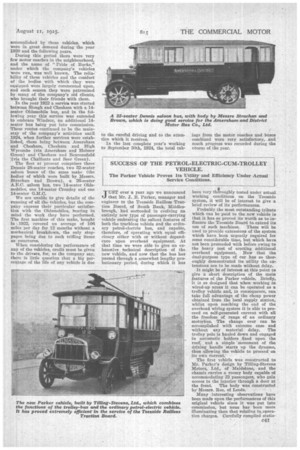SUCCESS OF THE PETROL—ELECTRIC—CUM-TROLLEY VEHICLE.
Page 25

Page 26

If you've noticed an error in this article please click here to report it so we can fix it.
The Parker Vehicle Proves Its Utility and Efficiency Under Actual Service Conditions.
TUST over a year ago we announced LI that Mr. J. B. Parker, manager and engineer to the Teesside Railings Traction Board, of South Bank, Middlesbrough, bad succeeded in evolving an entirely new type of passenger-carrying vehicle embracing the salient features of both the trackless vehicle and the ordinary petrol-electric bus, and capable, therefore, of operating with equal efficiency either with or without dependence upon overhead equipment. At that time we were able to give an exhaustive technical description of the new vehicle, and now that the bus has Passed through a somewhat lengthy probationary period, during which it has
been very thoroughly tested under actual
working conditions on the Teesside System, it will be of interest to give a brief review of its performances.
Probably the most outstanding tribute which can be paid to the new vehicle isthat it has so proved its worth as to influence the Teesside Board to extend its use of such machines. These will be used to provide extensions of the system which have been urgently required for some considerable time. but which have not been proceeded with before owing to the heavy cost of erecting additional overhead equipment. Now that the dual-purpose type of car has so thoroughly demonstrated its utility the extensions are to be made without delay.
It might be of interest at this paint to give a short description of the main features of the Parker vehicle. Briefly, it is so designed that when working in wired-up areas it can be operated as a trolley vehicle and, in consequence, can. take full advantage of the cheap power obtained from the local supply station, whilst upon reaching the end of the overhead wiring system it is able to proceed on self-generated current with all the -freedom of range of an ordinary motorbus. The change over can be accomplished with extreme ease and without any material delay. The trolley pole is hauled down and engaged in automatic holders fixed upon the roof, , and a simple movement of the driving handle starts up the dynamo, thus allowing the vehicle to proceed on
its own current. .
The first vehicle was constructed to Mr. Parker's design by Tilling-Stevens Motors, Ltd., of Maidstone, and the chassis carries a roomy body capable of accommodating 32 passengers, who gain access to the interior through a door at the front. The body was constructed
by Messrs. Roe, of Leeds. — Many interesting observations have been made upon the performances of this original vehicle since it was put into commission, but none has been more illuminating than that relating to operation charges. Carefully compiled statis
ties show that when working as a trolley-bus, deriving its power from overhead, the average operating cost of the vehicle has been 11.09d. per car-mile. When it is stated that the average working expenses per car-mile for the Board's entire fleet of 21 vehicles is 12.05d. it will be appreciated that the new vehicle is capable of effecting a very material saving. Prior to the advent of the combined vehicle the Straker-Clough cars showed the most gratifying results, their average cost per ear-mile being 11.28d.
When running under its own current the vehicle has been able to show equally satisfactory results, for its working expenses aggregated only 11.57d. per carmile. The average cost of running a combined vehicle was 11.15(1. per car
mile, from which it will be seen that the duties of the bus have been chiefly undertaken in those areas in which overhead equipment is installed.
The riding comfort of the bus and its absence of vibration are features which have been favourably commented upon, whilst passengers onthrough journeys to areas outside the customary radius of the undertaking's operations have been particularly pleased with the facilities which have enabled them to reach their destinations without having to change vehicles. This demand for non-change transport facilities is undoubtedly becoming greater, and the combined vehicle places at the disposal of authorities operating trackless services an eeonomic and convenient means of meeting this requirement.
At the present time the Teesside Raillegs Traction Board's system covers well over five miles, the various routes serving a vast population in the outlying indistrial districts of Middlesbrough. The services now operated are as follow :— North Ormegby via South Bank to Grang,etown, North Ortnesby via South Bank to Normanby.
The object of the purchase of a second combined vehicle is to enable the management to extend the system from Normanby Road on one section and from Grangetown on the other, to Eston Square, and doubtless other extensions will be considered as the demand arises.






























